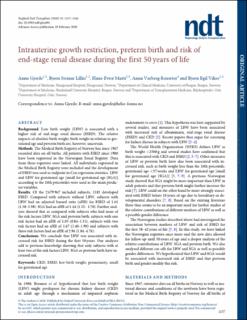| dc.contributor.author | Gjerde, Anna | |
| dc.contributor.author | Lillås, Bjørn Steinar | |
| dc.contributor.author | Marti, Hans-Peter | |
| dc.contributor.author | Reisæter, Anna Varberg | |
| dc.contributor.author | Vikse, Bjørn Egil | |
| dc.date.accessioned | 2021-02-25T08:35:09Z | |
| dc.date.available | 2021-02-25T08:35:09Z | |
| dc.date.created | 2020-10-04T12:50:56Z | |
| dc.date.issued | 2020 | |
| dc.Published | Nephrology, Dialysis and Transplantation. 2020, 35 (7), 1157-1163. | |
| dc.identifier.issn | 0931-0509 | |
| dc.identifier.uri | https://hdl.handle.net/11250/2730259 | |
| dc.description.abstract | Background:
Low birth weight (LBW) is associated with a higher risk of end-stage renal disease (ESRD). The relative impacts of absolute birth weight, birth weight in relation to gestational age and preterm birth are, however, uncertain.
Methods:
The Medical Birth Registry of Norway has since 1967 recorded data on all births. All patients with ESRD since 1980 have been registered in the Norwegian Renal Registry. Data from these registries were linked. All individuals registered in the Medical Birth Registry were included and the development of ESRD was used as endpoint in Cox regression statistics. LBW and LBW for gestational age [small for gestational age (SGA)] according to the 10th percentiles were used as the main predictor variables.
Results:
Of the 2 679 967 included subjects, 1181 developed ESRD. Compared with subjects without LBW, subjects with LBW had an adjusted hazard ratio (aHR) for ESRD of 1.61 (1.38–1.98). SGA had an aHR of 1.44 (1.22– 1.70). Further analyses showed that as compared with subjects who had none of the risk factors LBW, SGA and preterm birth, subjects with one risk factor had an aHR of 1.05 (0.84–1.31), subjects with two risk factors had an aHR of 1.67 (1.40–1.98) and subjects with three risk factors had an aHR of 2.96 (1.84–4.76).
Conclusions:
We conclude that LBW was associated with increased risk for ESRD during the first 50 years. Our analyses add to previous knowledge showing that only subjects with at least two of the risk factors LBW, SGA or preterm birth have increased risk. | en_US |
| dc.language.iso | eng | en_US |
| dc.publisher | Oxford University Press | en_US |
| dc.rights | Navngivelse-Ikkekommersiell 4.0 Internasjonal | * |
| dc.rights.uri | http://creativecommons.org/licenses/by-nc/4.0/deed.no | * |
| dc.title | Intrauterine growth restriction, preterm birth and risk of end-stage renal disease during the first 50 years of life | en_US |
| dc.type | Journal article | en_US |
| dc.type | Peer reviewed | en_US |
| dc.description.version | publishedVersion | en_US |
| dc.rights.holder | Copyright © 2020 The Author(s) | en_US |
| cristin.ispublished | true | |
| cristin.fulltext | original | |
| cristin.qualitycode | 1 | |
| dc.identifier.doi | 10.1093/ndt/gfaa001 | |
| dc.identifier.cristin | 1836839 | |
| dc.source.journal | Nephrology Dialysis Transplantation | en_US |
| dc.source.40 | 35 | |
| dc.source.14 | 7 | |
| dc.source.pagenumber | 1157-1163 | en_US |
| dc.identifier.citation | Nephrology Dialysis Transplantation. 2020, 35 (7), 1157–1163. | en_US |
| dc.source.volume | 35 | en_US |
| dc.source.issue | 7 | en_US |

